The Exciting Blend of SUP Boards and Sailing
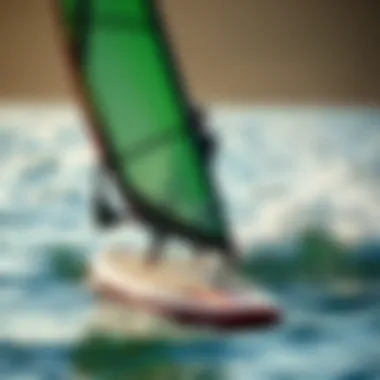
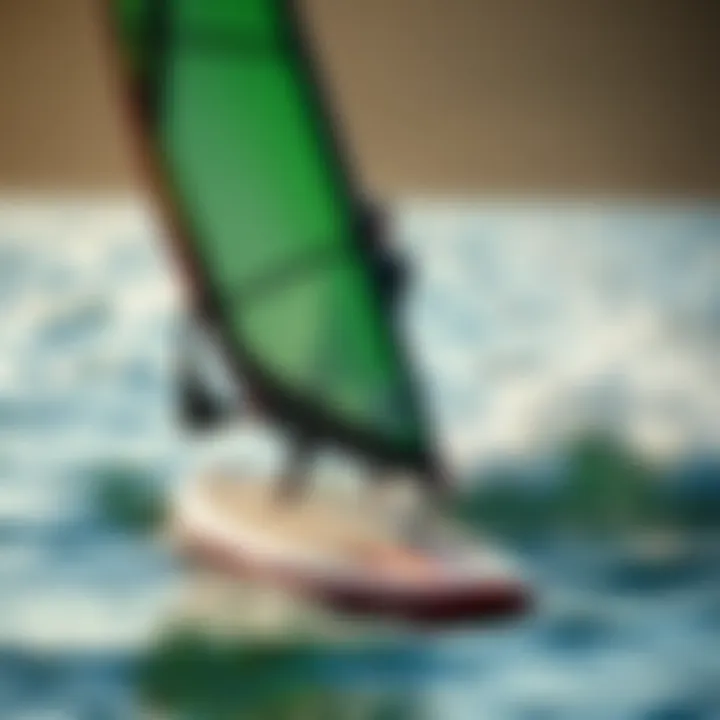
Intro
The water beckons with a promise of adventure, and it’s hard to resist the call of both stand-up paddleboarding (SUP) and sailing. Each sport, rich in its traditions and quirks, offers exhilarating experiences on the waves. However, an intriguing hybrid is emerging that combines the best of both worlds. By aligning sails with SUP boards, enthusiasts find a new frontier that amplifies enjoyment and engagement with the water. Whether you are a seasoned sailor or a paddleboarding novice, this novel blend could elevate your recreational pursuits.
As we explore this dynamic fusion, you will discover not only the optimal gear and techniques but also how this interplay between SUP and sailing can transform your water experience into something truly remarkable. It's not just about the thrill of gliding over waves; it’s about enhancing skill sets and creating lasting memories on the open water.
So, let’s dive into the essentials of gear, skills, and everything in between that can lead you to master this captivating combination.
Prolusion to SUP Boards with Sails
The fusion of stand-up paddleboards (SUPs) and sails brings a fresh perspective to the world of water sports. This innovative approach not only enhances the excitement of traditional paddleboarding but also broadens the scope of activities that enthusiasts can enjoy on the water. By incorporating sails with SUP boards, users can experience a unique blend of skills, utilizing both paddling and sailing techniques, leading to a more dynamic experience on the waves.
This article aims to provide insight into the significance of SUP boards equipped with sails, detailing their design, functionality, and advantages. Understanding this synergy is paramount for both newcomers to the sport and experienced users alike. The advent of SUP boards with sails opens up thrilling opportunities for exploration and fitness, while also emphasizing the importance of safety and maintenance.
Understanding the Concept
At its core, the combination of SUP boards and sails represents a revolutionary shift in water sports. Unlike traditional paddleboarding, where propulsion relies solely on human power, adding a sail introduces wind dynamics into the mix. This combination allows riders to harness the wind's energy, enabling them to travel faster and cover longer distances without exhausting themselves.
The design of these hybrid boards often includes specific features tailored to accommodate both paddling and sailing. For instance, the attachment points for sails must ensure stability without compromising the board's overall buoyancy. Furthermore, understanding how wind interacts with the sail requires knowledge of basic sailing principles, making it essential for users to familiarize themselves with both paddling and sailing techniques.
To truly appreciate this concept, one must recognize the accessibility it offers. Many people with limited experience in either activity can quickly learn to navigate their SUP with a sail. It's about merging the enjoyable aspects of windsurfing and paddleboarding, creating a versatile experience that can suit leisure trips or exciting adventures.
The Evolution of Water Sports
Water sports have undergone significant transformation over the years, evolving from simple recreational activities to complex disciplines that blend technology, skill, and artistry. SUP, in particular, burst onto the scene about a decade ago, quickly winning over enthusiasts with its simplicity and accessibility. As paddleboarding gained traction, innovators sought ways to push these boundaries further.
The introduction of sails is a natural progression in this evolution. Many enthusiasts recall a time when windsurfing was the go-to water sport for adrenaline seekers, and now, the influx of SUP boards with sails offers a more approachable alternative. They enable users to navigate a myriad of conditions, whether gentle breezes or stronger winds, appealing to a diverse audience of all skill levels.
- Key milestones in the evolution of water sports:
- The growth of paddleboarding as a mainstream activity.
- The merging of various water sports for a more diverse experience.
- Ongoing innovations that promote inclusivity and accessibility in water activities.
As we delve deeper into this topic, it's essential to reflect on how the merger of these two sports enhances the community. The combination of SUP boards and sails not only provides a new avenue for exercise but also fosters social interactions among enthusiasts. Together, they contribute to a vibrant culture that appreciates adventure, skill, and the beauty of the water.
Technical Specifications of SUP Boards
The topic of technical specifications for SUP boards is essential to understand the practical aspects of these boards, particularly when integrated with sails. Knowing the specifics about materials, dimensions, and weight can reshape your approach to both paddleboarding and sailing. These factors not only influence performance and maneuverability on the water but also dictate the overall user experience. Let’s break down key elements important for anyone looking to navigate the exciting waters that blend stand-up paddleboarding with sailing.
Materials and Construction
The material used in constructing a SUP board directly impacts its durability, performance, and ease of handling. Most boards have one of these constructions:
- Epoxy/Foam: This is the most prevalent construction method. The core is generally made of foam, encased in an epoxy layer. This combination offers a solid balance between lightweight properties and sturdiness, making it optimal for a variety of water conditions.
- Inflatable SUPs: A rising star in the SUP sector, inflatable boards are crafted from military-grade PVC and are highly portable. When deflated, they can easily fit in a backpack, a fabulous choice for those who love to travel but don’t want to lug around heavy equipment.
- Fiberglass: This material is often employed in performance boards. It provides stiffness and speed, which are crucial when you’re adding a sail to improve those wind-driven excursions.
Choosing the right material sets the stage for the entire SUP sailing experience. Different boards require different handling, so it becomes vital to match your expectations with the right material.
Dimensional Considerations
When we talk about dimensions, we often mean length, width, and volume. Each of these aspects plays a crucial role in a board's performance. Longer boards tend to excel in straight-line speed, making them ideal for competitive racing or longer journeys.
- Length: A board around 12 to 14 feet can cut through water more efficiently.
- Width: Wider boards offer enhanced stability, but they can be slower. This is particularly important when integrating sails. A broader stance can help maintain balance when wind catches the sail.
- Volume: This contributes mainly to buoyancy. Higher volume boards can support more weight; this is especially beneficial when you and your gear are on board.
If you are a beginner or prefer more stability, a shorter and wider board is likely your best bet. A perfect blend between size and wind conditions can provide the stability necessary for enjoying a seamless sail on your SUP board.
Weight and Stability Factors
The weight of the board can alter its stability both on the water and when introducing sails. Heavier boards can offer solid performance stability but may sacrifice speed and responsiveness. On the other hand, lighter boards are quicker and more maneuverable, but they necessitate careful handling, especially in gusty conditions.
- Stability: A general rule of thumb in water sports is that more stability leads to better performance in tricky spots. For SUP sailing, this factor is heightened. If the board isn’t stable, the whole experience becomes somewhat wobbly, not to mention dangerous.
- Weight Capacity: Different boards have various weight limits. A heavier setup could hinder your responsiveness in high wind, while lighter configurations may make you nimble yet susceptible to capsizing.
Ensuring that you balance all three factors – weight, volume, and dimensions – will maximize your enjoyment on both calm and breezy days.
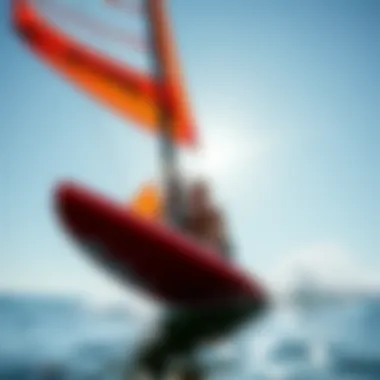
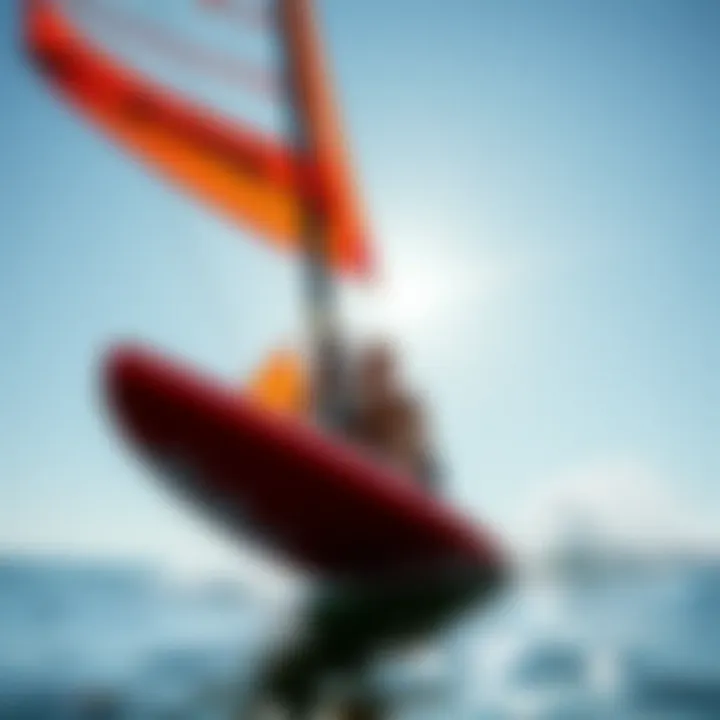
Understanding these technical specs is a leap towards mastering SUP sailing. When you have the right materials, measurements, and weight balance, you can smoothly navigate both relaxed strolls on calm waters and exciting sail-driven adventures.
In the world of SUP sailing, every detail matters. The right technical specification can mean the difference between a blissful sail and a chaotic tumble.
Sail Design for SUP Integration
In the realm of water sports, the confluence of stand-up paddleboarding (SUP) and sailing is becoming increasingly significant. Sail design is pivotal in this interplay, as it not only defines how users experience these activities but also optimizes performance on the water. When a sail is integrated into a SUP board, it can vastly alter how water is navigated, turning a simple leisurely paddle into an exhilarating ride powered by the wind. It adds layers of complexity, excitement, and versatility to what could otherwise be a straightforward activity.
A well-designed sail takes into account several crucial elements including materials, size, shape, and adaptability. These factors not just impact usability but also influence safety and performance. Each element needs to be considered carefully for a seamless integration that enhances user experience rather than complicates it.
"The right design can make the difference between floundering like a fluke or gliding like a gazelle."
Types of Sails Used
The types of sails utilized in SUP integration are varied, aimed at meeting different styles and preferences. Here are the most common:
- Soft Sails: Often made of lightweight, durable fabrics, these sails provide flexibility and are easy to handle. They are a favored choice for beginners due to their forgiving structure.
- Hard Sails: Constructed from rigid materials, hard sails offer enhanced performance and stability in varying wind conditions, making them suitable for more experienced users.
- Inflatable Sails: These unique designs combine buoyancy with wind-driving power, allowing for easy transport and setup. They cater to those seeking a lightweight option for recreational outings.
- Hybrid Sails: A blend of various materials and designs, hybrid sails aim for a balance between speed and maneuverability, appealing to a broad spectrum of paddleboarders.
Understanding the different types available guides users in selecting a sail that best suits their intended activities—whether that’s racing, exploring, or simply enjoying the wind beneath their feet.
Sail Size and Shape Considerations
The size and shape of a sail profoundly influence performance on the water. A larger sail will catch more wind, leading to faster speeds but also requiring more control, especially in strong winds. Conversely, a smaller sail can be easier to manage but might not harness enough wind power for exhilarating speeds. Thus, there is a delicate balance in sail sizing that influences speed and handling.
- Square Tops vs. Triangular Sails: Square tops may enhance power and stability, while triangular sails are generally more efficient in terms of speed and responsiveness.
- Aspect Ratio: This term refers to the relationship between the sail's height and width. A higher aspect ratio typically allows for improved aerodynamic efficiency, but can compromise stability.
When selecting size and shape, consider the sailing conditions, as well as personal experience level. In windy environments, a small, well-shaped sail may offer the best combination of speed and control, while beginners might prefer a more forgiving size.
In summary, the design of sails for SUP integration is a multifaceted subject, requiring attention to types, sizing, and shape. Each sailor needs to pick what combines performance with enjoyment. The right choice can lead to a richer, more fulfilling water experience, prompting everyone to seek out their next adventure on the waves.
Benefits of Using a Sail on a SUP Board
When it comes to exploring the waters with a stand-up paddleboard, adding a sail can transform your experience significantly. The hybridization of SUP and sailing isn’t just a passing trend; it presents a plethora of advantages that can cater to both novices and seasoned water enthusiasts. The combination elevates the overall efficiency and enjoyment of your time on the water, allowing you to glide smoothly and with purpose.
Enhanced Speed and Efficiency
One of the most well-known benefits of sailing on a SUP board is enhanced speed. With the wind in your sails, the board can reach higher speeds than paddling alone. This is essential when looking to cover longer distances. Consider a situation where you want to explore a vast expanse of a lake or wind your way through coastal waters. Instead of exhausting yourself, a sail serves as a natural engine that harnesses the wind's power, pushing you forward swiftly.
Moreover, it minimizes the physical effort needed to propel yourself. While paddling requires strength and stamina, sailing allows you to relax your muscles while still making substantial progress. For instance, on a breezy afternoon, you might effortlessly glide across the water, enjoying the surroundings while the sail does the hard work.
Broader Range of Activities
The integration of a sail expands the activities you can enjoy on the water. When you're operating solely with a paddle, the options can feel a bit limited to racing, touring, or simple leisure. However, when you add a sail, it opens up numerous possibilities like
- Windsurfing-like Maneuvers: You can engage in tricks and turns that are reminiscent of windsurfing but with the stability of a paddleboard.
- Pacing for Leisure Cruising: Whether you’re out for a relaxed day trip or planning an active day of exploration, the sail provides a new way to enjoy the scenery without too much exertion.
- Adventure Sailing: As you become comfortable with your sail, you can start planning day trips or even longer excursions, allowing for more versatile water adventures.
There’s a unique thrill when you harness the wind, moving as one with nature rather than just battling against the water currents. Literally shifting gears from paddling to sailing elevates your time on the water.
Improved Fitness Opportunities
Bringing a sail into your SUP routine doesn't just enhance speed or activity variety; it can significantly amplify fitness benefits. Balancing on your board while adjusting your sail requires core strength and stability, engaging a variety of muscle groups.
To get a clearer picture, think of the difference between gently paddling along a calm beach and actively managing a sail while navigating through wind and water. This is a full-body workout that requires:
- Core Stability: Your abdominal muscles are constantly engaged to maintain balance as you steer.
- Leg Strength: Your legs are working overtime to keep your footing and stabilize your position on the board.
- Shoulder Engagement: Handling the ropes and adjusting the sail develop shoulder muscles and upper body strength.
Each time you venture out with your sail, you’re not just enjoying the breeze, but you are also crafting an exercise routine that builds strength in a way that isn't just repetitive paddling. Over time, you may notice improvements in your overall fitness level, agility, and endurance.
"Combining SUP with sailing is like ice cream topped with chocolate; it enhances the flavor of the experience beyond imagination."
In summary, the benefits of using a sail on a SUP board extend far beyond just a new piece of gear. With increased speed, a wider range of activities, and improved fitness opportunities, it's clear that integrating a sail into your water sports repertoire is well worth considering. By understanding and embracing these advantages, users can enjoy a deeper, more exhilarating connection with their environment.
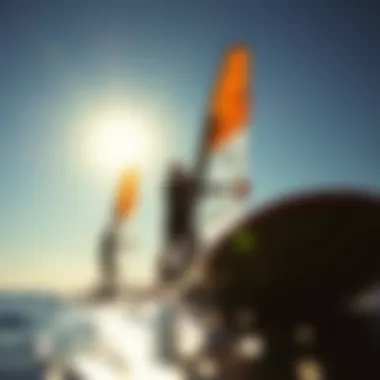
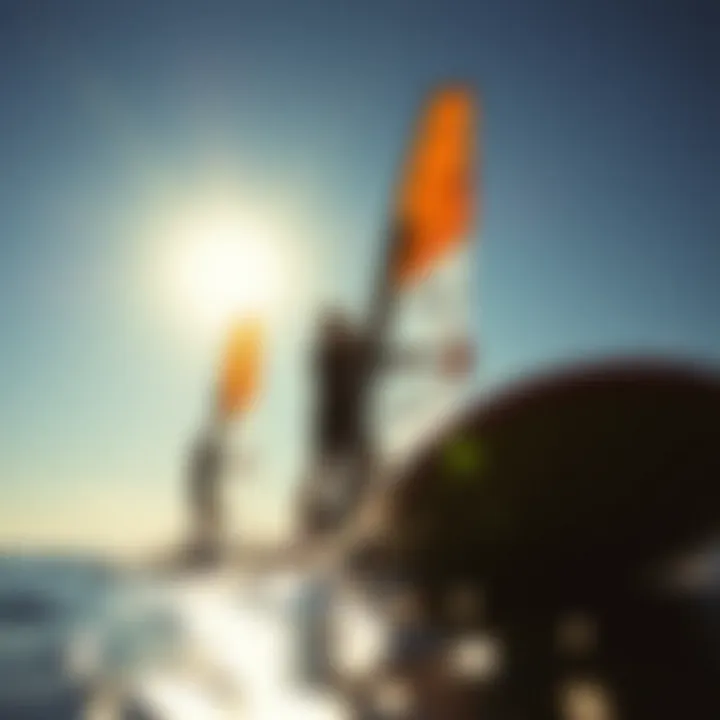
Techniques for Mastering SUP Sailing
Mastering the art of SUP sailing requires not just an understanding of the equipment but also a grasp of the techniques that enhance efficiency and safety on the water. Combining the stand-up paddleboard with a sail transforms a typical paddling experience into a dynamic sailing adventure. Being well-versed in the various techniques ensures that both novice and experienced users can navigate their SUP boards effectively, adapting to changing wind conditions and maximizing their sailing potential.
Basic Maneuvers
Understanding basic maneuvers is foundational when it comes to operating a SUP with a sail. These techniques determine how smoothly one can sail, turning a frustrating venture into a vibrant journey of excitement. Here are key maneuvers to get started:
- Tacking: This is essential for changing direction while sailing against the wind. The key is to angle the board into the wind and allow the sail to backfill, then adjust and steer around.
- Gybing: For when the wind is at your back and you need to switch directions. The process involves swinging the sail to the opposite side while shifting your weight accordingly to maintain balance.
- Reaching: This is sailing across the wind, which is often considered the simplest and most stable point of sail. Keeping the sail at a 45-degree angle captures the wind efficiently, allowing for smoother navigation.
Practicing these basic maneuvers provides the groundwork for advancement. It’s simple, yet for many, the learning curve can feel steep. Remember, patience is important. Secure a calm day with mild winds for your early sessions to build confidence.
Advanced Tactics for Control
Once you have the basics under your belt, diving into advanced tactics promises to elevate your sailing experience. Mastery of these strategies can turn a simple ride into an exhilarating experience.
- Foot Steering: Shifting weight from your feet allows for fluid direction changes. Keeping your stance wide and your body relaxed pays off when waves hit your SUP.
- Sail Trim Adjustment: Adjusting the sail’s angle can drastically impact speed and balance. Learning the right tension in your sail according to the wind conditions helps in achieving optimal performance.
- Wind Awareness: Developing a keen sense of wind direction is paramount. It’s about anticipating gusts and lulls before they happen. Observing the water surface can also signal changes in wind behavior.
Mastering these advanced tactics enhances performance on the water, making every outing not only smoother but also more enjoyable. The art of SUP sailing blends skill, awareness, and analytical thinking—a trifecta that turns budding enthusiasts into seasoned sailors.
"Adjust your sail according to the wind, but also mind your footing. Balance is as important as navigation."
By honing the basic maneuvers first and then transitioning to advanced techniques, users can build a solid skill set that will carry them through various sailing conditions. Each outing provides an opportunity to refine these skills, ensuring that every moment on the water is not just about reaching a destination but about enjoying the journey that unfolds.
Safety Considerations in SUP Sailing
In the exhilarating world of SUP sailing, where serenity meets adventure, safety is paramount. Engaging in this hybrid sport involves navigating various elements, making it crucial to develop a keen understanding of the associated risks and how to mitigate them. Not only does adequate preparation enhance the overall experience, but it also assures that enthusiasts can enjoy their time on the water, knowing they have taken the necessary precautions.
Understanding Weather Conditions
When it comes to SUP sailing, the skies can speak volumes. Understanding weather conditions is key to ensuring a safe outing. Enthusiasts should always check local forecasts before heading out, looking for factors such as wind speed, direction, and potential storm forecasts.
- Wind Speed: Ideally, a wind speed of 5 to 15 knots is favorable for most beginners. Anything beyond that can turn a pleasant paddle into a challenging endeavor. Winds over 20 knots can make sailing dangerous, especially if you're a rookie.
- Wind Orientation: Winds that come directly off the land can alter the water surface’s stability, often causing choppy conditions. The right understanding of wind can not only keep you safe but also enhance your sailing experience.
- Weather Patterns: Familiarity with the geography of the area can help in predicting sudden weather changes. For instance, coastal regions often experience swift weather shifts due to coastal breezes. Learning to read clouds and environmental changes can greatly aid in decision-making.
In short, staying informed about conditions is not just good practice; it’s the backbone of safety on the water.
Essential Safety Equipment
No sailor should hit the water without the right gear. The right equipment can mean the difference between a casual excursion and a perilous situation. Here’s a look at some essential safety equipment:
- Personal Flotation Device (PFD): Wearing a buoyancy aid is not just a smart choice; in many areas, it’s the law. A well-fitted PFD provides peace of mind and ensures flotation in case of an unexpected fall. Always opt for a vest designed specifically for paddling, as these are more comfortable and allow for better movement.
- Leash: A leash is crucial for keeping your board close in case of a spill. Though it may seem cumbersome, it prevents the board from drifting away, enabling swift recovery and reducing the risk of collision with other watercraft.
- Whistle: Although often overlooked, a whistle can be vital in emergency situations. It serves as a signaling tool that can grab the attention of passersby when required.
- First Aid Kit: Accidents can happen, so it’s wise to have a basic kit onboard. Ensuring you have band-aids, antiseptics, and any necessary personal medications is a practical step.
- Navigational Tools: A waterproof map or a smartphone with a good battery will help you keep track of your route and communicate in case of emergency.
When heading out for some SUP sailing, always remember that investing in the right safety gear is not just about compliance; it’s about common sense. Don’t let a lack of preparation turn into a regrettable outing.
"Safety doesn’t happen by accident; it’s planned and prepared for."
Maintenance and Care for SUP Sails
Taking care of your SUP sails is not just a good idea; it's essential for maintaining performance and maximizing lifespan. Like any piece of gear exposed to the elements, proper maintenance can mean the difference between smooth sailing and a frustrating day on the water. By understanding cleaning protocols and effective storage methods, sailors can prolong the life of their equipment and ensure every adventure is a breath of fresh air rather than a headache.
Cleaning Protocols
Cleaning your SUP sail should be top of mind after each outing. Saltwater, sand, and other grimy contaminants can find their way into every nook and cranny. Here's a straightforward method for keeping your sail as fresh as a daisy:
- Rinse Immediately After Use: As soon as you step off the water, take a moment to rinse off your sail with fresh water. This helps remove salt and sand, which can cause wear over time.
- Gentle Soap Scrub: If needed, mix a mild soap with water. Using a soft sponge, gently scrub your sail to lift stubborn dirt. Avoid abrasive materials that could scratch the surface.
- Avoid Harsh Chemicals: Steer clear of bleach or strong detergents since they can damage the fabric and stitching.
- Dry Thoroughly: After rinsing and scrubbing, hang your sail to dry completely. If you leave moisture trapped in the folds, you might be inviting mold or mildew.
These simple steps can extend the sail's life while keeping its appearance sharp. Ultimately, a clean sail is not just a visual treat but also vital for optimal performance.
Storage Tips for Longevity
When it comes to storing your SUP sails, treat them like fine wine. Proper storage helps maintain shape and integrity. Here are some tried-and-true tips that keep your sails in shipshape:
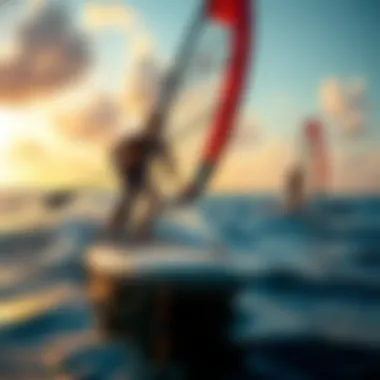
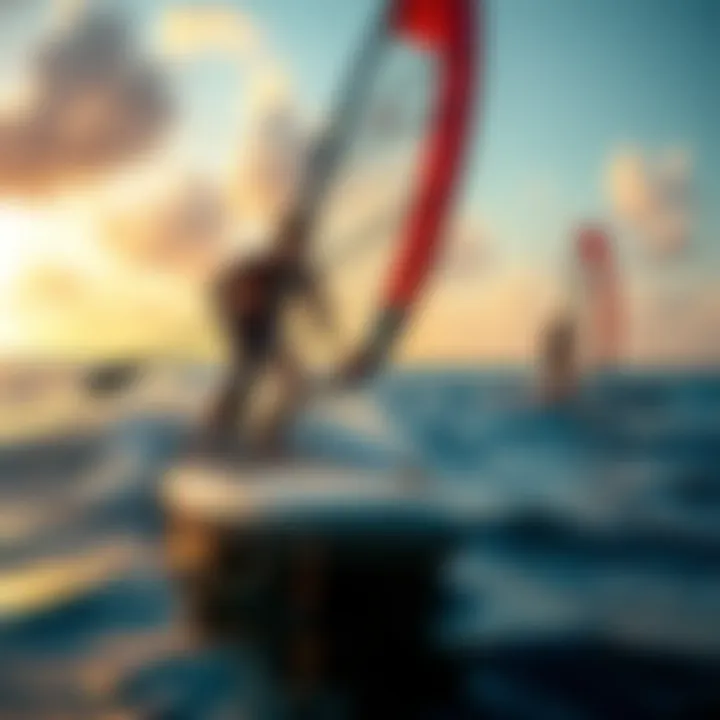
- Roll, Don't Fold: Rolling your sails instead of folding them reduces creases and potential stress points. This small step can make a huge difference.
- Cool, Dry Spot: Store your sails in a location that is not exposed to extreme temperatures or harsh sunlight. A garage or a closet works wonders, as long as it’s not damp.
- Avoid Weight on Top: Ensure nothing heavy is stacked on your sails. Weight can lead to permanent creases, leading to ineffective performance once back on the water.
- Use a Sail Bag: If possible, keep your sails in a dedicated sail bag to provide an extra layer of protection against dust and dirt.
"A well-maintained sail is not just a joy; it’s an investment in better sailing experiences."
By following these cleaning and storage protocols, you’ll find your SUP sailing sails remain in fine fettle, ready for whatever adventures lie ahead. Treat your gear with respect, and it will reward you with countless days of smooth sailing.
Environmental Impact of SUP Boards with Sails
The interplay between stand-up paddleboards (SUP) and sails generates not just a fresh perspective on water-based recreation but also raises essential questions about environmental impact. As these hybrid crafts gain traction among outdoor enthusiasts, it's crucial to explore how they affect our ecosystems and what measures can be taken to mitigate any negative consequences.
Sustainability in Materials
One significant aspect of the environmental discussion is the materials used in SUP boards and sails. Traditional boards often utilize polypropylene and foam, which have considerable energy costs in their production and contribute to plastic pollution. However, a marked shift has occurred toward sustainable materials. Manufacturers are now increasingly using recyclable composites and bio-resins that are easier on the planet's resources.
- Natural Fibers: Some boards incorporate natural fibers like bamboo, providing both flexibility and strength.
- Recyclable Plastics: Several brands are working on boards made from 100% recyclable materials, which can be broken down and reused after their life cycle.
- Eco-Friendly Paints and Coatings: These eliminate harmful volatile organic compounds (VOCs) that can negatively impact air quality both on land and in the water.
Choosing boards made with sustainable materials not only reduces the carbon footprint of production but also infuses a more eco-conscious ethos into the water sports community. This responsibility fosters a sense of stewardship among users, pushing them to be mindful of their environmental impact.
Upon energizing a board with sails, one might reasonably ponder the sources of the materials comprising that setup, as every piece has ecological importance.
Promoting Eco-Friendly Practices
With an understanding of sustainable materials comes the responsibility to promote eco-friendly practices among the sailing and paddling community. It's one thing to possess a sustainably made SUP board with a sail; it's another to use it in a manner that embraces and protects the environment.
- Leave No Trace Principles: Just like hiking, spending time on the water implies adhering to the Leave No Trace principles, ensuring one’s activities don’t disrupt wildlife or pollute waterways.
- Collaborative Cleanup Efforts: Many surf and paddle clubs organize community cleanups, which can turn a leisurely paddle day into a productive initiative for local waterways. This not only promotes environmental health but cultivates a sense of community and shared responsibility.
- Advocacy for Preservation Areas: Engage with organizations that lobby for the protection of marine areas. Supporting local regulations that limit pollution and sustain biodiversity is integral to the ethos of eco-friendly engagement.
Future Trends in SUP Sailing
In today’s ever-evolving landscape of water sports, the integration of technology and community dynamics is reshaping the experience for paddleboarders and sailors alike. The future of SUP sailing holds great promise with emerging innovations and collaborative ventures that can enhance user experience and foster a vibrant community. This section aims to illuminate upcoming trends that are nurturing this fascinating fusion, pinpointing key elements and their implications.
Innovations in Board Technology
The relentless march of technology has a profound impact on SUP boards. The next wave of advancements is prioritizing both performance and sustainability. A few notable trends include:
- Hybrid Materials: Manufacturers are experimenting with advanced materials that are lighter yet stronger, such as carbon fiber and recycled plastics. These boards offer enhanced buoyancy without compromising durability, allowing enthusiasts to glide effortlessly over water.
- Smart Technology: With the rise of IoT (Internet of Things), future SUP boards could be equipped with sensors that monitor performance metrics like speed, distance, and wind conditions. By connecting these metrics to apps, users can receive real-time feedback and tailor their sailing techniques accordingly.
- Modular Designs: Imagine a board that adapts to different conditions with interchangeable fins or sails. Modular designs enhance the versatility of SUP sailing, making it appealing to a broader range of users—from those just getting their feet wet, to seasoned sailors looking for performance optimization. This adaptability could greatly widen the participation in board sailing activities.
The implementation of these technologies not only offers practical benefits but also places sustainability at the forefront of design, aligning with the growing eco-consciousness among users.
Expanding Community Engagement
Community engagement is the heartbeat of any sport, and in the realm of SUP sailing, there are several exciting developments pushing this camaraderie to new heights. A few key elements are reshaping how enthusiasts connect and share their adventures:
- Online Platforms: Dedicated forums and social media groups, such as those found on Reddit or Facebook, provide a space for users to share experiences and tips. This digital interaction fosters community bonds and allows paddlers across the globe to exchange ideas on everything from gear to destinations. Platforms connecting experienced sailors with novices foster mentorship, ensuring the sport’s continuity.
- Events and Competitions: The organization of local and international competitions is gaining traction. Events not only elevate excitement but also empower participants to showcase their skills and learn from one another. Collaborative initiatives could combine SUP sailing with other water sports, amplifying the reach and engagement among varied audiences.
- Eco-Friendly Initiatives: Many communities are increasingly advocating for sustainable practices within the sport. By organizing beach clean-up events and educational workshops on environmental care, the community fosters a strong sense of responsibility. Engaging in such activities deepens the participants' connection to nature and raises awareness about the ecological impact of water sports.
As we look ahead, the synergy between technological advances and community participation presents a tantalizing glimpse into the future of SUP sailing. By building a robust network of innovative practices and engaging enthusiasts at every level, the sport is poised to thrive for generations to come.
"Innovation unlocks potential, while community keeps the flame alive. The future of SUP sailing lies at the intersection of both."
For further reading on the dynamics of water sports community engagement, you may refer to resources like Wikipedia and Britannica.
Finale
In this concluding section, we unravel the significance of the dynamic fusion of stand-up paddleboards and sails. As water sports enthusiasts, the combination of these two activities not only augments our fun but also opens new avenues for adventure. By understanding how SUP boards with sails work, users can appreciate the intricate design elements and technical specifications that make this hybrid option viable. This convergence enhances the experience by introducing increased speed and efficiency, enabling paddlers to cover larger distances without exhausting themselves.
Moreover, it broadens the range of activities one can engage in. Imagine gliding through calm waters with just a whisper of wind guiding your SUP. It’s not just about paddling anymore; you can now tack and jibe, creating a more dynamic way to enjoy the water. This transformation equips water lovers with an unparalleled fitness experience as the combination of paddling and sailing challenges the body in ways that traditional paddling cannot.
Furthermore, safety and maintenance considerations stand central to this discussion. Users must be equipped with proper safety gear and must pay attention to weather conditions. Understanding the nuances of sailing while on a SUP can prevent mishaps and enhance the enjoyment of the experience.
Ultimately, the exploration of SUP boards with sails is vital for anyone looking to enrich their interaction with water sports. Whether you're a newcomer or a seasoned hobbyist, integrating sailing dynamics into your regimen not only elevates your skills but also cultivates a stronger bond with nature.
Summary of Insights
In summary, the journey through the interplay of SUP boards and sails has revealed several pivotal insights. The growth of water sports, the manner in which technology enhances performance, and the environmental consciousness that is inherently tied to these recreational activities expose a rich tapestry urging enthusiasts to engage more deeply. Key takeaways include:
- Innovative Design: The merging of paddle and sail technology yields boards that are optimally constructed for both performance and enjoyment.
- Fitness and Skills: Engaging with SUP sailing paves the way for enhanced physical conditioning and new skill development, making it an alluring option for many.
- Community Engagement: Expanding on SUP sailing generates opportunities for camaraderie among enthusiasts, fostering a culture of shared experiences and growth in the sport.
Encouragement for Exploration
As we draw this article to a close, consider this an open invitation to dive into the art of SUP sailing. The allure lies not just in the act of paddling or sailing but in the fusion of these two worlds. As you explore this exhilarating combination, embrace the freedom of the open waters and the challenges they present. Embrace the chance to join a community that values adventure and exploration.
Why not grab a paddle and a sail and see where the wind takes you? Whether it's for fitness, leisure, or the thrill of mastering a new sport, the opportunities are endless, and your journey in the water starts now.







